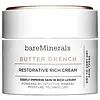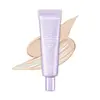What's inside
What's inside
 Key Ingredients
Key Ingredients

 Benefits
Benefits

 Concerns
Concerns

 Ingredients Side-by-side
Ingredients Side-by-side

Water
Skin ConditioningGlycerin
HumectantButylene Glycol
HumectantDimethicone
EmollientPentaerythrityl Tetraethylhexanoate
EmollientPropanediol
SolventTricaprylin
MaskingGlyceryl Stearate Se
EmulsifyingCetyl Alcohol
EmollientSilica
AbrasiveMyristyl Myristate
EmollientPEG-100 Stearate
Butyrospermum Parkii Butter
Skin ConditioningCopernicia Cerifera Wax
Hydrogenated Polyisobutene
EmollientHydrogenated Polydecene
EmollientBehenyl Alcohol
EmollientDimethylacrylamide/Sodium Acryloyldimethyltaurate Crosspolymer
Isostearic Acid
CleansingStearyl Alcohol
EmollientUrea
BufferingGlucosamine Hcl
Algae Extract
EmollientSaccharomyces Cerevisiae Extract
Skin ConditioningSodium PCA
HumectantAllantoin
Skin ConditioningEthylhexylglycerin
Skin ConditioningLauryl Betaine
CleansingSodium Citrate
BufferingDisodium EDTA
Sorbitan Tristearate
EmulsifyingPhytosteryl/Octyldodecyl Lauroyl Glutamate
Skin ConditioningAlcohol
AntimicrobialCitric Acid
BufferingCarbomer
Emulsion StabilisingPolysorbate 20
EmulsifyingSodium Hyaluronate
HumectantHypericum Erectum Extract
Skin ConditioningPalmitoyl Tetrapeptide-7
Skin ConditioningPalmitoyl Tripeptide-1
Skin ConditioningCeramide NP
Skin ConditioningTocopherol
AntioxidantParfum
MaskingGeraniol
PerfumingLimonene
PerfumingLinalool
PerfumingCitral
PerfumingSodium Benzoate
MaskingPhenoxyethanol
PreservativeWater, Glycerin, Butylene Glycol, Dimethicone, Pentaerythrityl Tetraethylhexanoate, Propanediol, Tricaprylin, Glyceryl Stearate Se, Cetyl Alcohol, Silica, Myristyl Myristate, PEG-100 Stearate, Butyrospermum Parkii Butter, Copernicia Cerifera Wax, Hydrogenated Polyisobutene, Hydrogenated Polydecene, Behenyl Alcohol, Dimethylacrylamide/Sodium Acryloyldimethyltaurate Crosspolymer, Isostearic Acid, Stearyl Alcohol, Urea, Glucosamine Hcl, Algae Extract, Saccharomyces Cerevisiae Extract, Sodium PCA, Allantoin, Ethylhexylglycerin, Lauryl Betaine, Sodium Citrate, Disodium EDTA, Sorbitan Tristearate, Phytosteryl/Octyldodecyl Lauroyl Glutamate, Alcohol, Citric Acid, Carbomer, Polysorbate 20, Sodium Hyaluronate, Hypericum Erectum Extract, Palmitoyl Tetrapeptide-7, Palmitoyl Tripeptide-1, Ceramide NP, Tocopherol, Parfum, Geraniol, Limonene, Linalool, Citral, Sodium Benzoate, Phenoxyethanol
Water
Skin ConditioningDibutyl Adipate
EmollientButyloctyl Salicylate
Skin ConditioningPropanediol
SolventEthylhexyl Triazone
UV AbsorberDiethylamino Hydroxybenzoyl Hexyl Benzoate
UV FilterNiacinamide
SmoothingDrometrizole Trisiloxane
UV AbsorberMethylene Bis-Benzotriazolyl Tetramethylbutylphenol
UV FilterGlycerin
HumectantTitanium Dioxide
Cosmetic Colorant1,2-Hexanediol
Skin ConditioningLactobacillus Ferment
Skin ConditioningPentylene Glycol
Skin ConditioningCaprylyl Methicone
Skin ConditioningCollagen Extract
Skin ConditioningPortulaca Oleracea Extract
Skin ConditioningNonapeptide-1
Skin ConditioningDipeptide Diaminobutyroyl Benzylamide Diacetate
Skin ConditioningAcetyl Hexapeptide-8
HumectantCopper Tripeptide-1
Skin ConditioningTripeptide-1
Skin ConditioningPalmitoyl Tetrapeptide-7
Skin ConditioningPalmitoyl Tripeptide-1
Skin ConditioningPalmitoyl Tripeptide-5
Skin ConditioningPalmitoyl Pentapeptide-4
Skin ConditioningPalmitoyl Hexapeptide-12
Skin ConditioningPentapeptide-3
Skin ConditioningHexapeptide-9
Skin ConditioningGlyceryl Glucoside
HumectantAlpinia Galanga Extract
Skin ConditioningBisabolol
MaskingPanthenol
Skin ConditioningTocopherol
AntioxidantBeta-Glucan
Skin ConditioningAdenosine
Skin ConditioningSqualane
EmollientSphingomonas Ferment Extract
Skin ConditioningEthylhexylglycerin
Skin ConditioningArgania Spinosa Kernel Oil
EmollientHydrogenated Lecithin
EmulsifyingCoco-Caprylate/Caprate
EmollientVp/Eicosene Copolymer
Decyl Glucoside
CleansingPolyhydroxystearic Acid
EmulsifyingDimethicone/Vinyl Dimethicone Crosspolymer
Skin ConditioningDimethiconol
EmollientTrisiloxane
Skin ConditioningSodium Polyacryloyldimethyl Taurate
Emulsion StabilisingPolyacrylate Crosspolymer-6
Emulsion StabilisingHydroxypropyl Methylcellulose Stearoxy Ether
Triethoxycaprylylsilane
Aluminum Hydroxide
EmollientSodium Stearoyl Glutamate
CleansingSodium Polyacrylate
AbsorbentXanthan Gum
EmulsifyingSchizosaccharomyces Ferment Filtrate
HumectantPolyether-1
Dicaprylyl Carbonate
EmollientButylene Glycol
HumectantBetaine
HumectantFructooligosaccharides
HumectantC12-15 Alkyl Benzoate
AntimicrobialMethylpropanediol
SolventDimethicone
EmollientHydrogenated Polyisobutene
EmollientIsononyl Isononanoate
EmollientPolyglyceryl-10 Stearate
Skin ConditioningFructan
Skin ConditioningCetearyl Alcohol
EmollientStearic Acid
CleansingButyrospermum Parkii Butter
Skin ConditioningPolyglyceryl-2 Dipolyhydroxystearate
Skin ConditioningInulin
Skin ConditioningInulin Lauryl Carbamate
Emulsion StabilisingCaprylic/Capric Triglyceride
MaskingDisodium Stearoyl Glutamate
CleansingCI 77492
Cosmetic ColorantCI 77491
Cosmetic ColorantWater, Dibutyl Adipate, Butyloctyl Salicylate, Propanediol, Ethylhexyl Triazone, Diethylamino Hydroxybenzoyl Hexyl Benzoate, Niacinamide, Drometrizole Trisiloxane, Methylene Bis-Benzotriazolyl Tetramethylbutylphenol, Glycerin, Titanium Dioxide, 1,2-Hexanediol, Lactobacillus Ferment, Pentylene Glycol, Caprylyl Methicone, Collagen Extract, Portulaca Oleracea Extract, Nonapeptide-1, Dipeptide Diaminobutyroyl Benzylamide Diacetate, Acetyl Hexapeptide-8, Copper Tripeptide-1, Tripeptide-1, Palmitoyl Tetrapeptide-7, Palmitoyl Tripeptide-1, Palmitoyl Tripeptide-5, Palmitoyl Pentapeptide-4, Palmitoyl Hexapeptide-12, Pentapeptide-3, Hexapeptide-9, Glyceryl Glucoside, Alpinia Galanga Extract, Bisabolol, Panthenol, Tocopherol, Beta-Glucan, Adenosine, Squalane, Sphingomonas Ferment Extract, Ethylhexylglycerin, Argania Spinosa Kernel Oil, Hydrogenated Lecithin, Coco-Caprylate/Caprate, Vp/Eicosene Copolymer, Decyl Glucoside, Polyhydroxystearic Acid, Dimethicone/Vinyl Dimethicone Crosspolymer, Dimethiconol, Trisiloxane, Sodium Polyacryloyldimethyl Taurate, Polyacrylate Crosspolymer-6, Hydroxypropyl Methylcellulose Stearoxy Ether, Triethoxycaprylylsilane, Aluminum Hydroxide, Sodium Stearoyl Glutamate, Sodium Polyacrylate, Xanthan Gum, Schizosaccharomyces Ferment Filtrate, Polyether-1, Dicaprylyl Carbonate, Butylene Glycol, Betaine, Fructooligosaccharides, C12-15 Alkyl Benzoate, Methylpropanediol, Dimethicone, Hydrogenated Polyisobutene, Isononyl Isononanoate, Polyglyceryl-10 Stearate, Fructan, Cetearyl Alcohol, Stearic Acid, Butyrospermum Parkii Butter, Polyglyceryl-2 Dipolyhydroxystearate, Inulin, Inulin Lauryl Carbamate, Caprylic/Capric Triglyceride, Disodium Stearoyl Glutamate, CI 77492, CI 77491
Ingredients Explained
These ingredients are found in both products.
Ingredients higher up in an ingredient list are typically present in a larger amount.
Butylene Glycol (or BG) is used within cosmetic products for a few different reasons:
Overall, Butylene Glycol is a safe and well-rounded ingredient that works well with other ingredients.
Though this ingredient works well with most skin types, some people with sensitive skin may experience a reaction such as allergic rashes, closed comedones, or itchiness.
Learn more about Butylene GlycolThis ingredient is also known as shea butter. It is an effective skin hydrator and emollient.
Emollients help soothe and soften your skin. It does this by creating a protective film on your skin. This barrier helps trap moisture and keeps your skin hydrated. Emollients may be effective at treating dry or itchy skin.
Shea butter is rich in antioxidants. Antioxidants help fight free-radicals, or molecules that may harm the body. It is also full of fatty acids including stearic acid and linoleic acid. These acids help replenish the skin and keep skin moisturized.
While Shea Butter has an SPF rating of about 3-4, it is not a sunscreen replacement.
Shea butter may not be fungal acne safe. We recommend speaking with a professional if you have any concerns.
Learn more about Butyrospermum Parkii ButterDimethicone is a type of synthetic silicone created from natural materials such as quartz.
What it does:
Dimethicone comes in different viscosities:
Depending on the viscosity, dimethicone has different properties.
Ingredients lists don't always show which type is used, so we recommend reaching out to the brand if you have questions about the viscosity.
This ingredient is unlikely to cause irritation because it does not get absorbed into skin. However, people with silicone allergies should be careful about using this ingredient.
Note: Dimethicone may contribute to pilling. This is because it is not oil or water soluble, so pilling may occur when layered with products. When mixed with heavy oils in a formula, the outcome is also quite greasy.
Learn more about DimethiconeEthylhexylglycerin (we can't pronounce this either) is commonly used as a preservative and skin softener. It is derived from glyceryl.
You might see Ethylhexylglycerin often paired with other preservatives such as phenoxyethanol. Ethylhexylglycerin has been found to increase the effectiveness of these other preservatives.
Glycerin is already naturally found in your skin. It helps moisturize and protect your skin.
A study from 2016 found glycerin to be more effective as a humectant than AHAs and hyaluronic acid.
As a humectant, it helps the skin stay hydrated by pulling moisture to your skin. The low molecular weight of glycerin allows it to pull moisture into the deeper layers of your skin.
Hydrated skin improves your skin barrier; Your skin barrier helps protect against irritants and bacteria.
Glycerin has also been found to have antimicrobial and antiviral properties. Due to these properties, glycerin is often used in wound and burn treatments.
In cosmetics, glycerin is usually derived from plants such as soybean or palm. However, it can also be sourced from animals, such as tallow or animal fat.
This ingredient is organic, colorless, odorless, and non-toxic.
Glycerin is the name for this ingredient in American English. British English uses Glycerol/Glycerine.
Learn more about GlycerinHydrogenated Polyisobutene is a synthetic polymer. Polymers are compounds with high molecular weight. Hydrogenated Polyisobutene is an emollient and texture enhancer.
In one study, Hydrogenated Polyisobutene showed better skin hydration levels than Caprylic/Capric Triglyceride. As an emollient, it helps keep your skin soft and hydrated by trapping moisture in.
Hydrogenated Polyisobutene is often used as a mineral oil replacement.
Learn more about Hydrogenated PolyisobutenePalmitoyl Tetrapeptide-7 (formerly Palmitoyl Tetrapeptide-3) is a lab-made peptide with anti-inflammatory and skin-repairing benefits. It's made up of four amino acids (glycine, glutamine, proline, and arginine) and palmitic acid (which helps it penetrate skin more effectively).
This ingredient helps reduce inflammation by limiting the production of interleukin-6 (IL-6), a chemical that triggers inflammatory responses, particularly after UV exposure.
Less inflammation = slower collagen breakdown and a longer-lasting, youthful appearance.
Palmitoyl Tetrapeptide-7 also stimulates collagen production and supports a healthier skin barrier.
Over time, this can improve skin firmness, hydration, and reduce the appearance of fine lines. It’s commonly paired with Palmitoyl Tripeptide-1 in the well-known Matrixyl 3000 complex for enhanced anti-aging effects.
This ingredient has been shown to be effective and safe in cosmetic use and you'll typically find it in small amounts (less than 0.01%).
Due to its palmitic acid base, it may not be safe for Malassezia folliculitis.
Read more about other common types of peptides here:
Learn more about Palmitoyl Tetrapeptide-7Palmitoyl Tripeptide-1 is also known as pal-GHK. It is made up of 3 amino acids and palmitic acid, a fatty acid that helps it absorb into skin more easily.
This peptide is as a signal peptide, meaning it tells the skin to produce more collagen. Collagen is the key protein that helps form the skin's structure and keep it plump, firm, and hydrated.
By boosting collagen production, this ingredient supports a stronger skin barrier and helps reduce the appearance of wrinkles.
You'll most likely see this ingredient paired with Palmitoyl Tetrapeptide-7 in the well-known Matrixyl 3000 complex. While results from in-house testing should be viewed cautiously, this peptide duo is among the most studied and widely used in modern skincare.
Due to its palmitic acid base, this ingredient may not be safe for Malassezia folliculitis.
Read more about other common types of peptides here:
Learn more about Palmitoyl Tripeptide-1Propanediol is an all-star ingredient. It softens, hydrates, and smooths the skin.
It’s often used to:
Propanediol is not likely to cause sensitivity and considered safe to use. It is derived from corn or petroleum with a clear color and no scent.
Learn more about PropanediolTocopherol (also known as Vitamin E) is a common antioxidant used to help protect the skin from free-radicals and strengthen the skin barrier. It's also fat soluble - this means our skin is great at absorbing it.
Vitamin E also helps keep your natural skin lipids healthy. Your lipid skin barrier naturally consists of lipids, ceramides, and fatty acids. Vitamin E offers extra protection for your skin’s lipid barrier, keeping your skin healthy and nourished.
Another benefit is a bit of UV protection. Vitamin E helps reduce the damage caused by UVB rays. (It should not replace your sunscreen). Combining it with Vitamin C can decrease sunburned cells and hyperpigmentation after UV exposure.
You might have noticed Vitamin E + C often paired together. This is because it is great at stabilizing Vitamin C. Using the two together helps increase the effectiveness of both ingredients.
There are often claims that Vitamin E can reduce/prevent scarring, but these claims haven't been confirmed by scientific research.
Learn more about TocopherolWater. It's the most common cosmetic ingredient of all. You'll usually see it at the top of ingredient lists, meaning that it makes up the largest part of the product.
So why is it so popular? Water most often acts as a solvent - this means that it helps dissolve other ingredients into the formulation.
You'll also recognize water as that liquid we all need to stay alive. If you see this, drink a glass of water. Stay hydrated!
Learn more about Water